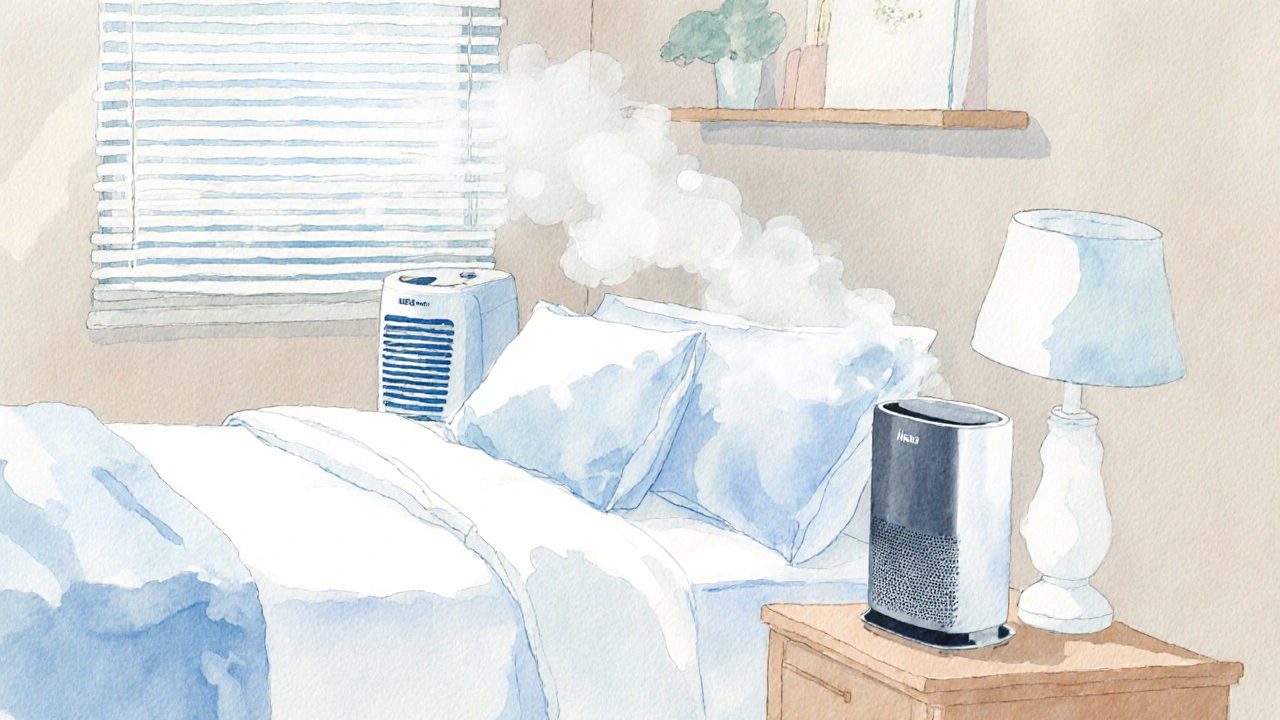Allergy Trigger Identifier
Track Your Symptoms
Log your symptoms and potential triggers to identify patterns and manage your allergies more effectively.
Your Symptom Log
Common Triggers on Campus
- Seasonal pollen: Pine, oak, and ragweed pollen can be present year-round due to indoor plants and landscaping.
- Indoor mold: Humid bathrooms and leaky roofs promote mold growth in carpets and ceiling tiles.
- Dust mites: Found in warm, upholstered furniture like dorm beds and couches.
- Pet dander: Lab animals or nearby apartments may release allergens even if pets are banned in residence halls.
- Cleaning chemicals: Strong disinfectants used by custodial staff can irritate sensitive individuals.
Key Takeaways
- Pinpoint indoor and outdoor triggers specific to campus life.
- Choose the right medication-antihistamines, nasal sprays, or immunotherapy-based on symptom severity.
- Transform your dorm with air purifiers, HEPA filters, and hypoallergenic bedding.
- Leverage campus health resources and know when to see an allergist.
- Adopt study‑friendly habits that keep symptoms from derailing your grades.
Understanding Year-Round Allergies on Campus
When you hear the word Allergies are immune system reactions to harmless substances like pollen, dust mites, or pet dander, most people picture spring sneezes and itchy eyes. The reality for college students is that allergens don’t take a semester off. Dorms, lecture halls, and even the cafeteria can host triggers that flare up any time of year. Recognizing that allergies are a continuous health factor is the first step toward staying on top of your coursework and social life.
Identify Your Triggers
Not all allergens are created equal, and on a university campus you’ll encounter a mix of outdoor and indoor culprits. Below are the most common triggers you’ll run into:
- Seasonal pollen: Even in Phoenix, pine, oak, and ragweed pollen can dominate certain months, but indoor plants and landscaping around dorms extend exposure.
- Indoor mold: Leaky roofs or humid bathrooms create a breeding ground for Mold spores that linger in carpet and ceiling tiles.
- Dust mites: These microscopic critters love the warm, upholstered environment of dorm beds and couches.
- Pet dander: While many campuses ban pets in residence halls, lab animals or nearby apartments can still release allergens.
- Cleaning chemicals: Strong disinfectants used by custodial staff can irritate nasal passages, especially for sensitive individuals.
Keep a simple log: note the date, location, and symptoms. After a couple of weeks you’ll see patterns that point to specific triggers.

Build an Allergy‑Friendly Dorm
Your living space is the epicenter of daily exposure. Small changes can dramatically lower the allergen load.
- Invest in an Air Purifier that uses a HEPA filter rated for at least 99.97% particle removal. Place it near your bed for night‑time relief.
- Swap out standard pillows for hypoallergenic pillows and mattress covers. These barriers block dust mites and mold spores.
- Wash bedding weekly in hot water (130°F/54°C) to kill allergens.
- Keep windows closed on high pollen days and use blinds instead of opening curtains.
- Declutter surfaces; fewer items mean fewer places for dust to settle.
Effective Medication Strategies
Medication is the backbone of symptom control, but the right choice depends on when symptoms hit and how severe they are.
Antihistamines are oral drugs that block histamine, the chemical responsible for itching, sneezing, and watery eyes. They work best for mild to moderate symptoms and are usually taken once daily.
Nasal sprays such as steroid or antihistamine sprays target inflammation directly inside the nose, offering rapid relief for congestion.
Below is a quick comparison of the most popular over‑the‑counter options. Choose based on speed of action, drowsiness risk, and duration.
| Medication | Active Ingredient | Onset | Typical Duration | Drowsiness Risk |
|---|---|---|---|---|
| Cetirizine | 2nd‑generation antihistamine | 30‑60min | 24hrs | Low |
| Loratadine | 2nd‑generation antihistamine | 1‑2hrs | 24hrs | Very low |
| Fexofenadine | 2nd‑generation antihistamine | 1‑2hrs | 24hrs | None |
| Fluticasone Nasal Spray | Corticosteroid | 12‑24hrs (full effect) | 24+hrs | None |
| Oxymetazoline (decongestant spray) | Topical decongestant | 5‑10min | 6‑12hrs | None |
For chronic sufferers, Immunotherapy is a long‑term solution that gradually desensitizes the immune system to specific allergens. Check with the campus health center to see if they offer allergy shots or sublingual tablets.
When to Seek Professional Help
Self‑management works for most students, but there are red flags that warrant a visit to a professional.
- Symptoms that persist despite daily medication.
- Severe congestion that interferes with sleep or class participation.
- Repeated sinus infections or asthma flare‑ups.
The College Health Center usually has a nurse practitioner who can prescribe stronger antihistamines, nasal corticosteroids, or refer you to an allergist for testing.

Study and Lifestyle Hacks
Allergies shouldn’t hijack your GPA. Here are some practical tweaks:
- Hydrate. Drinking water thins mucus, making it easier to clear allergens.
- Schedule indoor study sessions during high pollen forecasts; use the library’s air‑conditioned spaces.
- Take meds at consistent times. A morning dose of a non‑drowsy antihistamine can smooth the entire day.
- Carry a rescue inhaler or epinephrine auto‑injector if you have asthma or a history of anaphylaxis.
- Use saline rinses before bed to flush nasal passages of irritants.
Emergency Preparedness
Although most allergy attacks are manageable, a few can turn dangerous. Keep a small allergy kit in your backpack:
- One EpiPen (or equivalent) for severe reactions.
- Two doses of a fast‑acting antihistamine (e.g., diphenhydramine) for mild reactions.
- Contact info for your primary doctor and the campus health center.
Practice the steps: administer, call emergency services, and inform a nearby friend or roommate.
Resources and Apps
Technology can keep you a step ahead of pollen spikes and indoor air quality.
- Pollen Forecast Apps: Weather.com, Pollen.com, and local university extensions provide daily counts.
- Air Quality Monitors: Devices like Awair or the AirVisual app give real‑time indoor AQI readings.
- Campus Resources: Many universities host webinars on allergy management and provide free sinus rinse kits during peak seasons.
Combine data from these tools with your personal log to fine‑tune medication timing and environment tweaks.
Frequently Asked Questions
Can I take antihistamines while on campus exams?
Yes. Choose non‑drowsy, second‑generation antihistamines (like cetirizine or loratadine). They usually won’t affect focus, but test them during a low‑stakes study session first.
What’s the best way to reduce mold in a dorm bathroom?
Run the exhaust fan during showers, wipe down tiles after use, and keep a small dehumidifier if humidity stays above 60%.
Are natural remedies like honey or herbal teas effective?
They can soothe minor irritation but won’t replace antihistamines or nasal steroids for moderate‑to‑severe symptoms.
How often should I replace the HEPA filter in my air purifier?
Typically every 6‑12 months, depending on usage and indoor air quality. Most units have an indicator light.
What if my allergy medication makes me sleepy during lectures?
Switch to a non‑drowsy option or take the dose earlier in the day. Some students split the dose (e.g., half in the morning, half mid‑afternoon).


Hey folks, great rundown on campus allergens-definitely worth a look. I’d say start by logging every sneeze and itch in the app; patterns show up faster than you think. Keep your dorm windows shut on high‑pollen days and run an air purifier at night, that’s a game‑changer. Also, swapping out pillowcases for hypoallergenic ones can cut dust‑mite exposure dramatically. If you notice a spike after cleaning day, try a milder, fragrance‑free disinfectant. Stay on top of the meds schedule so you don’t miss a dose before a big exam. You’ve got this, just keep the routine solid and the symptoms will stay in check.
Honestly the guide hits the nail on the head-those hidden mold spores can really derail a semester. A quick dehumidifier in the bathroom and a weekly wipe‑down of tiles goes a long way. Also, consider a HEPA filter that whispers rather than roars; it’s less intrusive while still doing the heavy lifting.
Sounds like the key is consistency logging symptoms daily notice patterns over weeks see which spots trigger the most sneezes try adjusting study locations accordingly also keep a spare mask handy for unexpected pollen spikes
Keep windows closed when pollen counts are high.
🚀 Pro tip: pair your air‑purifier’s CADR rating with the square footage of your dorm room to calculate optimal air changes per hour; a 150 cfm unit in a 200‑sq‑ft space gives you roughly 5 ACH, which is ideal for mitigating particulate allergens 🌿.
Oi mate, ya think a tidy dorm will stop the sneezin’? Nah, the blasted pollen drifts in from the bleedin’ outside and those mold spores love a damp bathroom like it’s a five‑star resort! Get a proper dehumidifier and shut that damned window on windy days, or you’ll be snifflin’ all semester, trust me.